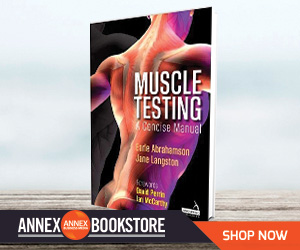| |
| |
 |
 |
| |
 |
|
@{mv_date_MMM d, yyyy}@ |
|
| |
New Year’s resolutions are an annual ritual of setting intentions for self-betterment, and health behaviour goals — such as improving healthy eating and physical activity — are among the most popular. Unfortunately, failing to stick to those new goals is so common that it has become a cliché.
» Read more...
When elderly people stay active, their brains have more of a class of proteins that enhances the connections between neurons to maintain healthy cognition, a UC San Francisco study has found.
» Read more...
If you’ve been spending more time at home during the pandemic, you may not realize how important proper footwear is for keeping certain injuries at bay.
» Read more...
|
| |
 |
 |
| |
|
| |

Muscle testing – A Concise Manual, provides a reference for understanding how structure relates to function, and how by knowing function we can learn structural configurations. Often muscular anatomy is taught as a dry subject whereby each muscle is painstakingly reviewed and the learner is expected to cite origin, insertion, action, nerve supply and blood supply. This commonly used approach may not necessarily aid understanding of muscle function, nor does it demonstrate muscular positioning. Through muscle testing, one is better equipped to consider how muscles function individually and in working groups. It is the knowledge of symmetrical movement, range of motion, contractile patterns, resistance and gravity that provides the fuller picture for muscle function and dysfunction.
» Shop now |
| |
|
| |
 Speech and swallowing weren’t on my radar at all. My goals were all about finding relief for the pain in my jaw – ways to decrease the pain and hypertonicity in my own TMJ.
I started taking a close look at every muscle that moves the jaw because working directly in the area of the temporomandibular joint itself only seemed to briefly dampen the pain, discomfort and tension. I began to palpate and thoroughly investigate the front of my neck (inferior to the mandible) and discovered that there was an incredible amount of hypertonicity in the suprahyoids and infrahyoids. After a thorough exploration and applying stretching to this musculature, I had the most relief I had ever felt in my TMJ – but it didn’t end there.
» Learn More
Speech and swallowing weren’t on my radar at all. My goals were all about finding relief for the pain in my jaw – ways to decrease the pain and hypertonicity in my own TMJ.
I started taking a close look at every muscle that moves the jaw because working directly in the area of the temporomandibular joint itself only seemed to briefly dampen the pain, discomfort and tension. I began to palpate and thoroughly investigate the front of my neck (inferior to the mandible) and discovered that there was an incredible amount of hypertonicity in the suprahyoids and infrahyoids. After a thorough exploration and applying stretching to this musculature, I had the most relief I had ever felt in my TMJ – but it didn’t end there.
» Learn More |
| |
|
| |
During this free webinar, you’ll learn: 5 ways to increase your income without working in a clinic; How to adapt your practice to meet growing patient demand; The tools and costs associated with setting up you own remote practice in your community; 3 zero-cost marketing strategies to get started and grow your referrals
» More info
|
|
Are massage therapists properly equipped, in their training and informed by evidence, to respond appropriately to patient affect, particularly in advanced care situations?
» Listen now
| | |
|
| |
|
|
| |
| |






